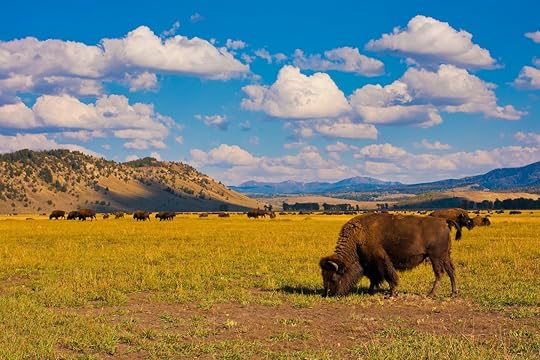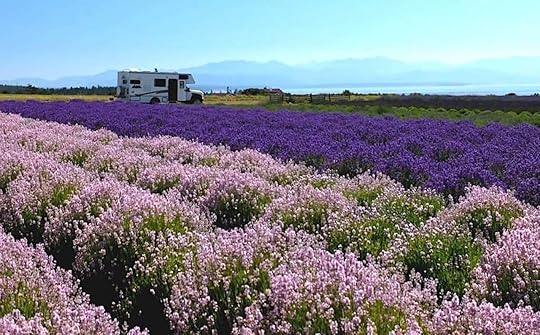Matador Network's Blog, page 795
August 28, 2020
Positive sustainability news

This is The Climate Win, the most positive sustainability news around the world every week.
Last week, Electrify America, which operates one of the largest electric vehicle (EV) charging networks in the United States, announced a partnership with truck stop and convenience store operator Love’s Travel Stops. Together, they’ll expand their cross-country routing of charging stations by developing 28 new, ultra-fast EV charging stations at the common highway travel centers in six states — New York, Oklahoma, Florida, New Mexico, Utah, and Arizona. Many are open, and all are set to be completed by early 2021.
“Providing EV drivers with the opportunity to charge their vehicles at Love’s locations will help instill confidence for longer interstate trips, and can encourage more consumers to consider making the switch to electric,” said Rachel Moses, senior manager for site acquisition, development and strategy at Electrify America, in a press release.
That statement highlights the increasing ease of driving cross-country in an electric vehicle. Electrify America is set to complete the second of its cross-country highway charging station routes this year, and has helped make it possible to drive across nearly all of the contiguous US without having to worry about running out of charge.
This is not just a great win for the climate. It’s also emblematic of a growing economic shift. While the number of gas stations still greatly outnumbers the number of EV charging stations — somewhere around 1.2 million to 50,000 — the ratio of electric vehicles to charging stations is now significantly better than the ratio of gas pumps to traditional cars, according to EVAdoption.
Putting charging stations at existing gas stations and travel stops eliminates the need for the development of specific charging centers, allowing drivers to make only the same stop for fuel, snacks, and restrooms as they would have in traditional vehicles. This keeps money flowing into travel centers and the towns where they are located. A 350 kW charger like the ones being installed at Love’s Travel Stops can add 20 miles of range per minute in many EV models. With Ford and other major auto manufacturers pledging to produce increasingly higher quantities of electric vehicles, travel centers and convenience stores will see a growing benefit to having EV charging stations.
This connects to the broadest takeaway from the six months of positive sustainability news coverage in this column: The adoption of sustainable practices scales when it meshes with economic flow, and it scales at a much faster rate when it benefits the economy. For travelers, this is huge because if the global carbon footprint of transportation goes down, the ability to move across town, and even around the country, is less harmful to the places we visit.
This also makes powering transportation through renewable sources increasingly cheaper than not doing so. And this, of course, allows more people to visit new places, which in turn leads to an increased desire to protect those places — but that’s another story in itself.
More climate wins
Adding EV charging stations may be something that convenience stores and travel centers opt for sooner than later, given current economic trends. Bloomberg reported that Exxon was booted from the Dow Jones Industrial Average this week, a major blow to the oil and gas giant that had been the DJIA’s longest-running stock. Pfizer Inc. and Raytheon Technologies Corp. were also given the boot, all being replaced by tech giants, a sign that the stock market and its major indexes might be getting “woke” — at least slightly.
Chicago is getting a massive new urban farm. Waste Dive reported that a community group has secured grant funding to turn a nine-acre brownfield into an urban farm. The farm is set to be almost entirely circular. Green Era Sustainability will compost the farm’s waste, and the farm’s urban location makes it a massive step toward environmental justice in the city. Part of that waste will generate what’s known as “renewable natural gas,” a biomethane gas that is converted to have similar properties as fossil-fuel natural gas, and sold to BP.
A study published in the journal Optics Express has found an efficient way to harvest energy from the air even when the sun isn’t shining. They’re known as anti-solar panels, and use a process called “optimal radiative cooling” to generate energy by converting the difference between the temperature of the air and that of a specially cooled area of the panel. The result is passive nighttime power generation that can complement the passive daytime power generation created by traditional solar panels. This could revolutionize renewable energy production, particularly in developing areas and in countries located near the poles, which see massive fluctuations in the amount of available daylight throughout the year. 
More like thisPaddlingA multi-day rafting trip on the Green River is the escape we all need right now
The post Driving cross-country in an electric vehicles keeps getting easier appeared first on Matador Network.

Banksy funds rescue boat

Famous, anonymous, British street artist Banksy secretly financed a yacht to rescue migrants from Africa who are trying to reach Europe, risking their lives in the process. The boat is called Louise Michel after a French feminist anarchist, and departed from Burriana, Spain, on August 18 to roam the Mediterranean Sea in search of people in distress.
On Thursday, the experienced crew rescued 89 people, including 14 women and four children. Now it’s looking for a safe port so passengers can disembark, or be transferred to a coast guard ship. Fittingly, the ship features some of Bansky’s artwork — a girl in a life vest holding a safety buoy shaped like a heart.
The MV Louise Michel just refueled after the first successful rescue operations last week and is now going to a standby position, fully ready to rescue. #DefendSolidarity #LouiseMichel pic.twitter.com/64UGtZoHlC
— LouiseMichel (@MVLouiseMichel) August 25, 2020
The ship’s mission had remained secret until now for fear that European authorities would compromise the project.
Banksy became involved in the rescue mission back in September 2019, when he emailed Pia Klemp, the former captain of several NGO rescue boats that have saved thousands of lives over the years. His email to her read, “Hello Pia, I’ve read about your story in the papers. You sound like a badass. I am an artist from the UK and I’ve made some work about the migrant crisis, obviously I can’t keep the money. Could you use it to buy a new boat or something? Please let me know. Well done. Banksy.”
While Klemp thought the message was a joke at first, Banksy’s desire to be involved was very real and has already come to fruition in a big way. 
More like thisNewsNew Banksy art promoting mask-wearing appears in the London Underground
The post Banksy-funded rescue boat has already saved 89 migrants in distress appeared first on Matador Network.

First Latina to climb K2

Viridiana Álvarez Chávez just became the first Latina to climb the world’s deadliest mountain, adding to her already impressive list of accomplishments.
Chávez climbed three of the world’s tallest mountains between 2017 and 2019 — Mount Everest in Nepal, K2 at the border of China and Pakistan, and Kanchenjunga in Nepal. K2 is considered to be the deadliest of the world’s five tallest mountains. Under 400 people have reached the top of K2, and 90 have perished in the attempt.
During her ascent, she watched another climber fall to their death, which caused her to freeze in place for several minutes. Despite the frightening sight, she decided to press on to finish summiting the 28,251-foot-tall mountain.
You might think that Chávez has always been a climber in peak physical shape, but that’s not actually the case. She only started exercising in her late 20s, and climbing about seven years ago. Now, she’s conquered the world’s deadliest mountains and holds the Guinness World Record for the fastest female ascent of the top three highest mountains with supplementary oxygen in just one year and 364 days.
According to Guinness World Records, Chávez’s next project is to summit the 14 highest mountains in the world and become the first person from North America to achieve this goal. 
More like thisClimbingThis epic new film ‘Breathtaking’ follows climbers on the world’s most dangerous mountain: K2
The post Viridiana Álvarez Chávez is the first Latina to climb the world’s deadliest mountain appeared first on Matador Network.

Rent an entire island in China

If you’ve ever wanted to start over from scratch and build a life on your very own island, now you can. You may never have considered China, but the Chinese government is renting 500 uninhabited islands located in the northeastern Liaoning province with rent starting at $535 a year.
Rent prices are based on a six-tier scale, according to the size of the island, the presence of marine life and beaches, and how complex the plans for its development are. The cheapest option starts at $535, while the most expensive offering is valued at $3.6 million yearly for 2.5 acres.
If you’re interested in renting, you’d need to thoroughly explain to the Chinese government what you want to do with the island. The government wants to encourage the development of tourism, fishing, agriculture, and urban areas.
In addition to stating your plans, you’d need to prove that you won’t be doing anything that may harm the local marine habitat and environment, as the government has come under fire multiple times for creating artificial islands and destroying the surrounding nature.
If you’re interested in making an island your home, you can look for inspiration from some of the other islands in the Liaoning province that have already been developed for tourism, such as Dalu Island featuring manicured gardens, sandy and mud beaches, and a traditional pagoda. 
More like thisNewsA new luxury glamping resort is opening near Acadia National Park
The post You can rent your very own island in China starting at $535 a year appeared first on Matador Network.

August 27, 2020
Japanese Wara Art Festival

Rice is one of Japan’s staple foods and a mainstay of its agriculture industry. The cereal is traditionally harvested by hand in autumn, though it can also be done via machine. Regardless of the method, after rice is harvested and the grain taken out, what’s leftover is rice straw — known as wara in Japanese — and Niigata City has come up with a creative way to keep it from going to waste through its annual Wara Art Festival.

Photo: Niigata City
Rice straw is generally reused for everyday purposes like feeding livestock and roofing; in the past, it was a common material used to make fashion accessories like shoes and purses. Niigata City, located in Niigata Prefecture, a major rice-producing region, decided to take the concept of reuse and recycle to the next level. In 2008, the city collaborated with locals and students from Musashino Art University in Tokyo to sponsor an event where artwork would be created using rice straw. It would ensure that the leftovers didn’t go to waste, all the while fostering a sense of community.
The sculptures were built by applying rice straw over wooden structures; they were then displayed at several locations in the area and were an instant hit. The festival has taken place every year since at Uwasekigata Park, with local artists, Musashino students, and more coming together to create artwork.

Photo: Niigata City
The sculptures have a different theme every year, and in addition to that, the festival also has hands-on classes, musical and dance performances, and local specialty products for sale. It usually runs from late August to late October and is free to the public, but it’s canceled in 2020 due to the COVID-19 pandemic. 
More like thisNewsThis outdoor art exhibit in Japan blends art and nature to transport you into a dream world
The post Japan’s Wara Art Festival takes a cultural staple and turns it into amazing art appeared first on Matador Network.
New David Attenborough documentary

It’s not news that the world’s considerable meat consumption is a threat to the planet. Sir David Attenborough is the latest to make the case for a plant-based diet, addressing the high environmental cost of meat and dairy farming in the new Netflix documentary A Life on Our Planet. Perhaps hearing these inconvenient truths from everyone’s favorite naturalist will finally convince some meat-eating fans to give vegetarianism a go.
Though Attenborough is beloved for his soft, buttery narration of nature documentaries like Planet Earth, his words in A Life on Our Planet are anything but soothing: “Human needs have overrun the world,” he says in the film’s trailer. “Our planet is headed for disaster.”
Large-scale livestock production contributes to global issues like deforestation and shrinking biodiversity. According to The Independent, Attenborough warns of a bleak future should we not change our collective habits: “By 2030 the rainforest turns into a dry savannah, altering the global water cycle. The Arctic becomes ice-free, global warming increases, frozen soils release methane and accelerate climate change dramatically,” the 94-year-old reportedly says in the film. “By 2080 global food production enters crisis, soils overused, weather more unpredictable. The planet becomes four degrees warmer, large parts of the world become uninhabitable.”
One solution A Life on Our Planet recommends is driving down the demand for meat by eating less of it. Attenborough’s endorsement of plant-based eating comes following his work on the 2017 nature documentary series Blue Planet II in which he promoted sustainability by encouraging universal efforts to curb plastic consumption.
A Life on Our Planet will debut on Netflix this fall. 
More like thisVegetarian2020 is the year to try a vegan hotel. These are the world’s best.
The post It’s time to go vegetarian, says Sir David Attenborough in new documentary appeared first on Matador Network.
Yellowstone & Grand Teton road trip

The summer of the road trip is fast approaching its collision with the autumn of the road trip. Fall foliage, cooler temperatures, and reduced crowds await — as long as you know where to look. Grand Teton and Yellowstone National Parks are striking all year round, but after experiencing them accented by the seasonal colors in autumn, you’ll never come back in July again. While both parks can be crowded even this time of year, the steps below will help you get more nature for your buck in both parks, and an excellent night out in Jackson to boot.
Hike to Lake Solitude in Grand Teton National Park

Photo: Kris Wiktor/Shutterstock
At the base of the Tetons, Jenny Lake puts you within a stone’s throw of more places that will take your breath away than nearly anywhere else in Grand Teton National Park. Problem is, this is no secret. But if you’re willing to take a long day hike, you can escape almost all of the crowd that heads to Jenny Lake just to reach Inspiration Point.
The Cascade Canyon Trail starts on the far side of Jenny Lake and runs from Inspiration Point around Teewinot Mountain to the backside of the Tetons, offering views of the jagged peaks that most visiting the park will never see. The trail is 4.13 miles one-way and connects to the Lake Solitude Trail, which takes you another 2.36 miles to the lake itself. Round-trip, that’s just shy of 13 miles — but the hike is pleasant, largely flat (except for the first part to Inspiration Point), and offers many spots at which to stop for a snack or hop into the stream to cool off.
To get to the trailhead, park at Jenny Lake and take the ferry across the lake. Round-trip ferry tickets cost $18 for adults and $10 for children. As a warning, the final return boat departs from the trailhead at 6:00 PM — don’t miss it. You could hike around the lake on the Jenny Lake Trail, but it adds about five miles round-trip to an already long hike.
Rent kayaks and paddle across Jackson Lake from Spalding Bay

Photo: B Brown/Shutterstock
Spalding Bay is among the most overlooked put-in spots on Jackson Lake. This is because it requires 10 minutes of dirt-road driving over a moderately maintained service road to get to, something most RV and sedan drivers of the world aren’t going to attempt. Most who get on the water at Jackson Lake do so from the other side of the lake, so aside from a few in-the-know water hounds who’ve done their research, you’ll have the put-in and the pristine paddle towards Elk Island, Deadman Point, and Moran Bay largely to yourself. And you can park 20 feet from the water — a major perk when you need to unload and haul a kayak.
To get to Spalding Bay, head down Teton Park Road from the southern entrance to Grand Teton National Park and turn off at the unmarked Spalding Bay Road. It’s easy to miss, but it’s the next turn-off following the well-marked Jenny Lake Road. Reserve kayaks from Rendezvous River Sports in advance. Pick up and drop off are easy, and the shop crew will even load the kayaks into, or onto, your vehicle and secure them if necessary.
In Jackson, experience “mountain town chic” on the perfect date night

Photo: f11photo/Shutterstock
Jackson, and indeed all of Wyoming, embody the spirit of the west in 2020 much as they did in 1820. But that doesn’t mean you can’t enjoy a night of refined elegance. The Hotel Jackson, right downtown on Town Square, is the place to do so. A stay here is an era-jumping experience, with the door staff donning cowboy hats and impressively personal service. You’ll enter into a fresh, modern lobby with a massive library that’s equal parts coworking haven and historical reading room. Rooms are modern and comfortable, accented by a gas-powered fireplace and offering views of downtown — the perfect respite from the crowds.
Don’t leave the hotel for dinner. FIGS, located onsite, serves excellent Lebanese dishes and, in a further nod to the globe-spanning pull of the nearby parks, an incredible mezcal cocktail. If you’re feeling adventurous, opt for the sampler menu, a thorough introduction to Lebanese and Mediterranean cuisine that includes staples like hummus and baba ghanoush along with kebabs, falafel, and kibbeh. The bar has wine or cocktails to match.
After dinner, walk over to the Million Dollar Cowboy Saloon. The promoted draw here is the nightly live country music, but the actual pull is the cheap beers and people-watching. Nowhere else in Jackson do old cowboys comingle with mountain bikers on holiday quite like they do here. Before heading back to the room, wander through the antlered gates of Town Square Park, among the most iconic sights in Jackson.
Do the big Yellowstone sights early

Photo: YegoroV/Shutterstock
Yellowstone National Park is home to most of the world’s sulfurous geysers, more wildlife than you’d see in a full cross-country drive, and a canyon with a waterfall that rivals any worth visiting. The park is amazing and, as such, better-trafficked — the loop drives through its grounds, anyhow. Very few of those who visit Yellowstone actually venture beyond the geyser boardwalks and easy-access viewpoints found in every guidebook.
Wake-up calls at 4:30 AM aren’t appealing on workdays, let alone on vacation. But the ultimate experience in Yellowstone’s Lamar Valley depends on it. Located in the park’s north, the Lamar Valley has come to be known as America’s Serengeti due to the ease of spotting not just the occasional wildlife but entire herds of animals with minimal effort. Most visitors to the park know this, and as such, many guided tours head to the valley following the first cup of morning joe.
Your goal is to take your joe to go and arrive at the Lamar Valley by 6:00 AM. The bison and elk that hang closer to the road are early risers and can often be seen grazing lazily as the sun ascends overhead. You’ll be among the first there to snap photos. Further away, wolves meander the hills and brush, so don’t forget your binoculars and long-distance camera lens. Your reward for waking up while it’s still dark outside is catching glimpses of any animals scared off by swarming automobiles.

Photo: Lorcel/Shutterstock
The biggest tip for actually enjoying your trip to the world’s first national park is to avoid anywhere that has a full parking lot plus cars lined up on the side of the road. Sadly, many of the must-dos inside Yellowstone are accompanied by such overcrowding, most notably Old Faithful and the nearby Norris Geyser Basin. If you’re in the parking area for the most famous of geysers by 6:45-7:00 AM, you’re looking good for a front-row view to the next eruption and then an easy escape from the madness to hit the Norris Geyser Basin before it gets too out of hand. After that, head to the paint pots to see mud oxidized into different colors.
Take a hike and catch fall colors

Photo: Serge Yatunin/Shutterstock
Should you be willing to put in the most minuscule of on-foot efforts, you’ll be almost as secluded as that lone bison grazing just out of reach of the casual pair of binoculars. The Fairy Falls Trail Overlook is a great example. This five-mile trail leads to Grand Prismatic Spring and the Imperial Geyser, which is not as well-known as Old Faithful but is far easier to get an undisturbed shot of. Even if you don’t hike the entire trail, the route is gorgeous, and the odds of a wildlife sighting are high. Do the bucket list items first thing, and then head to the Fairy Falls Trailhead parking lot once the park begins to fill up with vans and RVs.
For fall foliage in the park, head to Blacktail Plateau Drive or Mammoth Hot Springs, each lined with the bursting colors of aspens contrasted against the yellow grasses of the surrounding landscape. You likely noticed it in the morning, but Lamar Valley is another spot that “wows” in Autumn. 
More like thisOutdoorGrand Lake is the best town to base your Rocky Mountain adventure
The post This epic fall road trip to Yellowstone and Grand Teton bypasses the crowds appeared first on Matador Network.
Solo kid hot air balloon pilot

You probably don’t remember what you were doing on July 10. Well, eight-year-old JT Head was breaking the world record for being the youngest person to pilot a hot air balloon. The fourth-grader from Georgia piloted the balloon solo for 20 minutes, which was just long enough to break the world record.
JT flew 400 feet over the Sautee Valley in Georgia completely by himself. If anyone was in a good position to break the record, it was probably him, as his father owns a hot-air balloon company.
“My dad owns a hot air balloon company,” JT told 11ALive, “so I got really interested in hot air balloons, and so I decided that I wanted to do a solo flight one day.”
“You have to be really prepared!” exclaimed Head, describing the importance of practice. “‘Cause you have to know what all the handles and buttons do, like some turn on the propane tank and some turn on the burner”
According to JT, breaking the record had been a longtime goal of his — ever since he was four years old.
Previously, the record had belonged to a nine-year-old boy named Bobby Bradley. Shortly after JT completed his flight, Bradley graciously reached out to congratulate him.
Apart from actually breaking the record, his favorite part was the sights themselves. “I saw the sun setting,” he said, “I saw a lot of cows. My favorite thing was probably seeing the back of Yonah Mountain.” 
More like thisTrip PlanningThe 7 most amazing places to go hot-air ballooning around the world
The post Eight-year-old boy becomes youngest person to pilot a hot air balloon solo appeared first on Matador Network.
Winery, brewery, farm RV park

RV parks are great, but if you’re looking to take your RV somewhere with a bit more character, you’ll often find yourself out of luck. But don’t despair because there’s now an annual pass that lets you park at tons of cool destinations around the country. The Harvest Hosts membership allows RV owners to park overnight for free at over 1,225 wineries, breweries, farms, museums, and other attractions all across the US and Canada. All it’ll cost you is an annual fee of $79 — and for an additional $40 per year, you can also add over 350 golf courses and country clubs to your list of accessible parking.

Photo: Harvest Hosts
Lisa Manning, Member Services Manager at Harvest Hosts, told Business Insider, “Many state parks and campgrounds are either closed or have limited their parking spots. Also, RV sales are at record highs so there are more people competing for the parking spots that are available.”
Some of the program’s most unique attractions include tequilaries, aviation museums, wildlife rescue facilities, an alligator ranch, maple sugar farms, cider mills, and u-pick operations. But even if you can’t score one of these amazing spots, there are plenty more cool places to choose from.

Photo: Harvest Hosts
To book an overnight location, you must use the Harvest Hosts mobile app. The only requirements are that you must own a self-contained RV and are strongly encouraged to spend money at each location as a thank you to the hosts. 
More like thisCampingRVs are the way to travel this summer. Here’s where to hit the road.
The post RV camp for free at more than 1,200 wineries, breweries, and farms with this membership program appeared first on Matador Network.
The best hot cheese dishes

Strands of gruyere dripping from a fondue spoon. A buttery grilled cheese sandwich with cheese that stretches from piece to piece as it’s pulled apart. Melted cheese is a performance of the delicious, tempting and beguiling. It doesn’t just taste like heaven, it has the looks to match. No one knows this better than Polina Chesnakova, the award-winning writer behind the Russian-Georgian food blog Chesnok. To her, warm, melted cheese is the most iconic and beloved member of the comfort food family. The appeal, she thinks, lies in the fact that it is inherently dramatic.
“I think you’re starting to set the stage whenever you start melting the cheese,” Chesnalova muses. “I kind of love to watch the cheese start to melt and blister. It not only excites you, but everyone around you. You bring the pot of fondue to the table or you take out your tray of sizzling French onion soups, and there’s a moment before you dig in where everyone is watching the hot cheese. Everyone is hypnotized.”
Chesnakova loves cheese so much that she wrote an entire cookbook that’ll be published on September 1 this year, Hot Cheese, that exalts the versatility of this near-universally beloved ingredient. Cheese appears across cultures, from North and Central America to Eastern Europe, to the Middle East, and to South Asia. Children all over this planet grew up eating cheese at snack time, at sleepovers, and birthday parties. To know it is to love it forever.
“People always love hot cheese,” Chesnakova says. “It’s something that almost everyone grew up with, and it’s found in almost every culture that eats dairy. So it’s something that is familiar to everyone. And I think that familiarity kind of enshrouds it with the feeling of comfort and coziness.”
Here, Chesnakova elaborates on the role of cheese in Georgian cuisine, and why nostalgia is a key ingredient in the best hot cheese dishes.
Cheese in Georgian cuisine

Photo: Chronicle Books/Paul Sirisalee
Chesnakova and her family immigrated to America from Georgia, a country with a rich diary culture. Cheese is a constant on the Georgian dinner table. Chesnakova recalls eating khachapuri — boat-shaped bread filled with melted cheese and topped with raw egg — at nearly every family gathering and holiday. She included her favorite recipe for Adjaruli khachapuri, from the Adjara region of Georgia, in her cookbook. Traditionally, it’s made with Georgian sulguni cheese, though her version is filled with a combination of mozzarella, ricotta, and feta.
Khachapuri might be the most iconic Georgian cheese dish, but dairy eating traditions in the country include complex and wide ranging flavors and dishes. In Georgia, meals are theater, an elaborate dance of family-style dishes that emphasize sharing and pleasure. These feasts are known as supra.
“In Georgian culture they don’t really have different courses,” explains Chesnakova. “The table is filled with all sorts of dishes, to the point where you can’t even really see the table. As part of that initial spread, you’ll have a platter of cheese that you can snack on with puri bread, [as well as] the herbs, the tomatoes, cucumbers. And then the hot dishes come out.”
There are three types of cheese that appear at the Georgian dinner table: sulguni, a “semi soft, fresh cheese that has the texture of mozzarella, but the freshness briney-ness of feta,”; guda, a funky cheese produced in the Georgian mountains; and karkhunli, which Chesnakova describes as “really briney and really pungent.”
The hot dishes that come out after the small plates often feature cheese, too. Polenta is popular throughout Georgia, where sulguni is often shaved over the top of the dish to create a gooey topping for the creamy cornmeal. There’s also cheese wrapped in mint leaves, which is aromatic when you cut into it.
The best dishes to eat with melted cheese

Photo: Chronicle Books/Paul Sirisalee
According to Chesnakova, for a hot cheese dish to be a hit, it should incorporate two essential elements. The first is that it should be shareable.
“Whether it’s a fondue or cheese dip, or baked brie, it kind of attracts the crowd,” she says. “Hot cheese is so alluring that everyone is drawn to the table to eat.”
Many of her favorite hot cheese dishes right now can be enjoyed with a group (and in the era of COVID-19 that means whoever has been initiated into your quarantine bubble in the past few months). Chesnakova says she’s been eating pizza at least once a week — the pizza recipes in Hot Cheese include ingredients like soppressata, hot honey, fontina, and radicchio, but perhaps the dish she’s come to love the most is one she thinks is often overlooked: the quesadilla.
“You have jalapeno and red onions and you use the Oaxaca cheese which just melts really well and it has a bit of cotillo which is kind of like a Mexican style Parmesan,” Chesnakova says. “It’s really salty and nutty. It’s filled with minced chives and leeks and red onion and green onion. That’s so many different types of onions but their pungency is able to cut through the richness of the cheese. Then you get the fried tortilla, and you dip it into the sour cream. I could probably eat that for dinner every night.”
The second element for a hit hot cheese dish is taste. The best hot cheese dishes often trigger nostalgia. In fact, most of the recipes that Chesnakova included in Hot Cheese were inspired by dishes she grew up eating. Tomato soup and grilled cheese, for instance, elicits a “vivid childhood memory”; her elevated version in the cookbook includes fennel and blue cheese croutons. She also includes recipes for chicken cordon bleu, which she grew up eating, and for her fiance’s mother’s hatch chili rice casserole — recipes that she says “really bring back a lot of good memories.”
That might be the real power of hot cheese: Yes, it is deliciously satisfying, but each bite can also thrust you into the past to relive happier times surrounded by family, laughing or playing with friends in the summer, or snuggled up at home in the winter. Each strand of salty, creamy melted cheese contains a love spell that brings loved ones closer — perhaps now more than ever we need a reminder of how the right meal can restore happiness, even if just for a moment.
“Everyone comes together not just to eat hot cheese, but to help cook, too,” Chesnakova says. “Hot cheese invites everyone into the kitchen, and that’s always my aim.” 
More like thisFood + DrinkWhy Ireland makes the best cheese you probably haven’t tried
The post The best melted cheese dishes in the world, according to the author of ‘Hot Cheese’ appeared first on Matador Network.
Matador Network's Blog
- Matador Network's profile
- 6 followers



